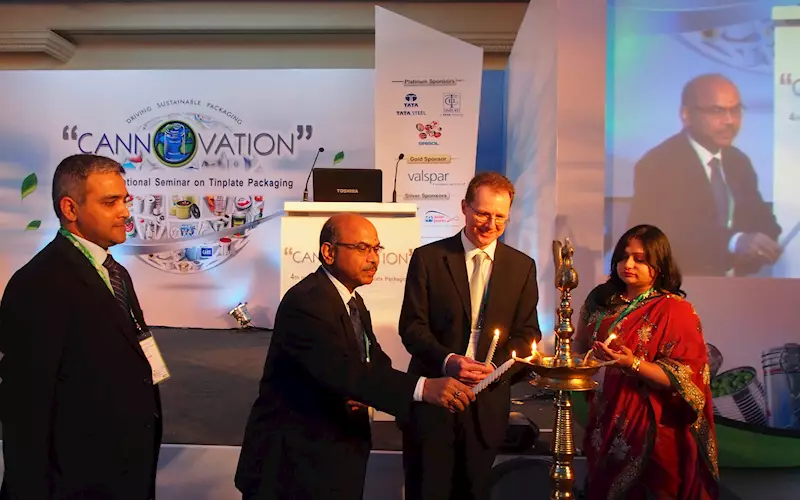The Tinplate Promotion Council’s fourth edition of Cannovation, the international seminar on tinplate packaging, was hosted at Taj Lands End in Mumbai on 27 February 2015, where all the stakeholders unanimously agreed to the need for end-users to know about new innovations and sustainability aspects of tinplate as a packaging material to fuel the growth of the sector.
Addressing an audience of over 250, Indian Institute of Packaging's director, Dr NC Saha, spoke on the advantages of tinplate for food packaging. He said, "It is the most versatile and eco-friendly packaging, which boasts of excellent barrier, aroma retention, high-impact resistance and is 100% recyclable, all at the same time. The tinplate industry in India is growing at 6-7% per annum."
The day-long Cannovation echoed a common sentiment that the growth in tinplate segment is limited when compared with the alternative packaging materials, considering metal packaging contributes to 10% of the packaging material pie in India and the overall packaging industry growth rate of over 15%.
From tinplate manufacturers to converters and from coating specialists to brand owners, the international seminar savoured a diversified line-up of speakers.
Representing tinplate manufacturers, Saket Bhatia of Hindustan Tin Works highlighted the challenges faced by the tinplate sector: cut-throat competition, industry fragmentation, shortage of skilled force, and lesser growth as compared with other materials. “We need to benchmark ourselves with global standards, benchmark the innovations and localise them and engage proactively with our customers,” said Bhatia.
Bhatia also highlighted the new technologies in tinplate manufacturing that need to be conveyed to the end-users. “Today, cans are 46% lighter than 30 years ago. There are acid free pickling processes available for etching of steel, which eliminates the need of oiling after etching, lower tin coating weight, improved passivation layer, sustainable lacquers and new recycling technologies are to name a few,” added Bhatia.
Dr Shubh Gautam, president and CEO of Srisol Group, spoke about localising packaging innovations to position a product in the Indian market during his presentation ‘Innovation for Make in India'. He explained this with a case-study of Kellogg’s poor performance in the initial stages in India. “The reason was cultural mis-match and it had to compete with home-cooked food. To set things right Kellogg had to Indianise its products. The effort to develop products, specifically for the Indian market helped Kellogg make significant inroads into the Indian market,” said Gautam.
In another session, Ramaiah Muthusubramanian, category packaging development director, Unilever, shared three case-studies highlighting three emerging packaging needs: convenience, sustainability and digital media.
Ramaiah spoke about relaunch of Ponds talcum powder package in form of a cylindrical bottle with simple open and close mechanism, which won a silver award at DuPont Global Packaging awards. “It was a sustainable package with optimum packaging. With this packaging, we could save 640 metric tonne of plastic per annum,” said Ramaiah.
Ramaiah also spoke about the convenience aspect of packaging in a cosmetic cream lamitube, a dispensing pump for ease of use, and augmented reality embedded into Axe package.
Speaking about the importance of tinplate, Ramaiah said, “Tinplate is more relevant in today’s scenario for three reasons: differentiating as a reusable pack, works well as festive and promotional pack and sustainable pack format.”
Ashwani Kumar, chief technologist for packaging and graphic, ITC India and a key speaker at the Cannovation, discussed how to develop an understanding of the consumer to guarantee packaging breakthrough.
Packaging is very different depending upon the industry. He stressed how emotion is the key for packaging innovators and developers need to constantly consider this, however very often it is ignored or forgotten.
In order to guarantee outstanding packaging, we need to put ourselves in the shoes of the consumer and see packaging from the customer’s point of view. To highlight this, he told the story of Mr Mittal v/s Mr Mittal. One, a rustic, rural-based office goer in Agra and the other a suave player in New York.
Kumar spoke about how Mr Mittal - I consumed his daily chai from a traditional cup at a tea stall, on the banks of the Yamuna. Mr Mittal - II travelled on the NY underground and consumed his first cup of coffee at the Starbucks. Mr Mittal in Agra had his lunch from the dabba he packed from home. While Mr Mittal from Manhattan ordered his sandwiches along with Heinz ketchup; always.
Kumar stressed that while the industry tended to tie up millions in equipment; there is very little synergy with emotional linkages and the story of the customer.
The tremendous potential that tinplate as a packaging material possesses and the usability in varied applications was highlighted in a concurrent exhibition where one got a firsthand look and feel of the latest happenings in metal packaging with key exhibitors like AkzoNobel, Unique UV, Fuji Kikai, Tata Tinplate.











 See All
See All